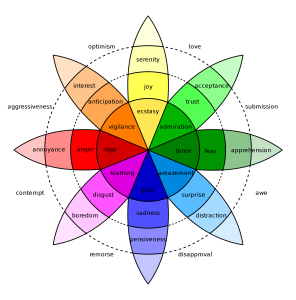What Are The Basic Emotions?
Negative Emotions – Part 2

Robert Plutchik theory. 22 October 2017. Wiki Media Commons.
Basic emotions
There are numerous theories as to how many basic emotions we have such as: theory by Paul Ekman, The James-Lange Theory of Emotion, The Cannon-Bard Theory of Emotion, Schachter-Singer Theory, Richard Lazarus’ Cognitive Appraisal Theory, and others.
Basic emotions are the building blocks of more complex experience of emotions. It is very difficult to define definitively the ‘gospel truth’ of emotions but we can identify them in a manner that can help us to better understand what it is that we are feeling and also what healthy emotions can possibly look like.
We can look at emotions in opposites, much like an antonym in vocabulary, or as in a colour wheel, or even in temperature such as hot and cold. We often refer to these opposites as positive and negative emotions. A friend and colleague of mine, Katie O’Shea renamed these as Connective and Life Enhancing Emotions and Protective and Life Preserving Emotions.
Protective Emotions
Shame and Guilt
Shame and guilt though similar are different but can fit into the same category. This emotion brings to our attention when we have or others have done something harmful. This emotion can work for us even before we have done something we should not have done, it can show us ahead of time that by doing a certain behaviour we can bring harm to someone either emotionally or physically. Often this emotion is referred to as a part of our conscience. This emotion brings to our attention behavioural changes we need to make. When we are skewed in our emotions that is when we need help. Guilt and shame when felt too much we feel as though we were bad versus our behaviour was bad. Some of what we feel with this emotion includes morals which sits in spirituality or religious beliefs.
Self-Pity
When we didn’t do anything wrong but something harmful has happened to us we need to feel sorry for ourselves. As the saying goes, lick your own wounds, we may need to do so in order to pay attention to how we have been hurt and what we need to pay attention to so that we can tend to ourselves and receive the healing, rest and emotional nourishment that we need. Where self-pity is unhealthy is when a person gets stuck in this feeling and continues to play the victim. Don’t pay attention to those who may say, “Don’t feel sorry for yourself”, as this may prolong your wound. Paying healthy attention to a physical wound is important so physical infection does not settle in so it is with emotional wounds. If you push emotions away they will stay and not heal. Pay attention to those emotions and care for yourself giving yourself what is healthy and needful.
Disgust
Understanding disgust is when we are repulsed where we react to eliminating something from us that is toxic, poisonous or dangerous. Disgust can be experienced when we taste something that is experienced as repulsive and we spit it out and withdraw from that thing. We can experience this when someone does something that is morally depraved or what we call “sick” or a food that is rotten, or a puss that might be oozing out. Disgust is experienced when we quickly feel the need to remove ourselves from that experience or behaviour. We need to pay attention to this feeling as it tells us when we need to remove ourselves from that situation or people otherwise we will become like them in some manner.
Fear
Fear lets us know when we are in danger. Not all fear is a correct assessment of the situation but healthy fear we can see in the example when a person is standing on the edge of a building 10 stories up and they know that to take a step off of the building that they will fall and die. Healthy fear also understands that jumping in front of a moving train will kill them. Unhealthy fear is when we experience some form of this emotion when there is no danger present. Fear gives us the energy to respond to a danger that is present whether emotional or physical, usually this response is a flight response.
Anger
Anger gives us the energy to fight when faced with a danger whether emotional or physical. Again, this emotional response may not be correct due to incorrect perceptions of the brain. On the scale of 0-10 when we experience a 5 or more we reject the person rather than the deed and when it is under a 5 we reject the deed rather than the person. Anger has different intensities from annoyance to wrathful hatred. Anger can be expressed through bodily expressions, facial, tone of voice, volume of voice as well as words chosen to be expressed. Anger has been referred to as a secondary emotion because it is an emotions that fights to regain power, for example I am angry because I was afraid, much like a fearful dog cornered becomes vicious.
Sadness and Grief
Sadness and grief show us that we have lost something or someone that is valuable to us. The more important that person or thing was to us the more intense the sadness. Healthy sadness and grief come when we embrace the feelings versus try and push them away. We need to reflect on the wound of loss once embraced we should be able experience gratitude because we are noticing the good that we once had either in a relationship or a thing such as a job. Sadness can also show us that we need to love and appreciate the relationships we make and have as well as respecting things that we have. Complicated grief arises when childhood attachments and connections were not of good quality.
Negative emotions are really needful as they are life preserving emotions that help protect us when we need it.
Negative emotions or feelings can be helpful when we need to protect our life from danger but when they are working at the wrong time then our life can become troublesome. When we ask, “Why am I feeling this way?” “Can I ever feel different?” “Is there any hope of me feeling better?” The answer is yes. There is no magic wand or special pill but there are clinical and therapeutic ways that can help us regain our life. Check out some of the therapies below that can help you.
>> EMDR Therapy
>> Homeopathy
At New Hope Counselling Centre we can help you to improve your emotional state, marriage, healthy living, bringing you hope for a better tomorrow. Call us today!
Serving Burlington, Hamilton, Oakville, Milton, Mississauga, St. Catharines and surrounding areas.
 Written by James A. Miklos, MCC. James has been counselling providing mental health therapy for over 25 years. James has numerous publications and periodicals, he has also self-published the book, “The Biblical Art of Dream Interpretation”. He also is available for speaking engagements as well as conducting workshops and seminars as well.
Written by James A. Miklos, MCC. James has been counselling providing mental health therapy for over 25 years. James has numerous publications and periodicals, he has also self-published the book, “The Biblical Art of Dream Interpretation”. He also is available for speaking engagements as well as conducting workshops and seminars as well.
In addition, James Miklos holds memberships and accreditations with the following recognized organizations:
- College of Registered Psychotherapists of Ontario
- CASC – Canadian Association for Spiritual Care
- ACTA – The Association of Counselling Therapy of Alberta Registered as Counselling Therapist
- EMDR Canada
- EMDRIA
© 2021 James A. Miklos. All rights reserved. To copy or quote any of this material the entire citation and credit must be posted.





